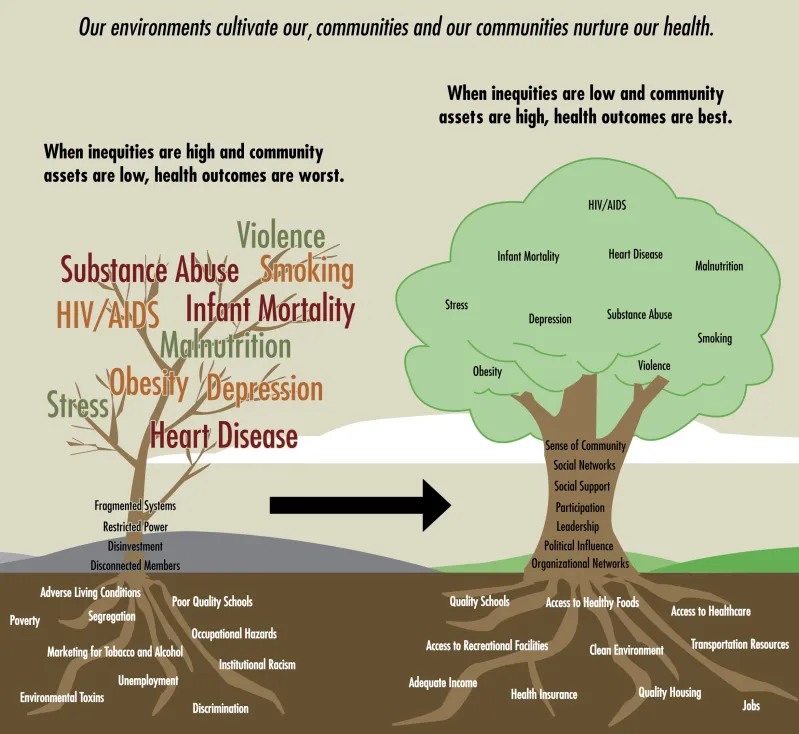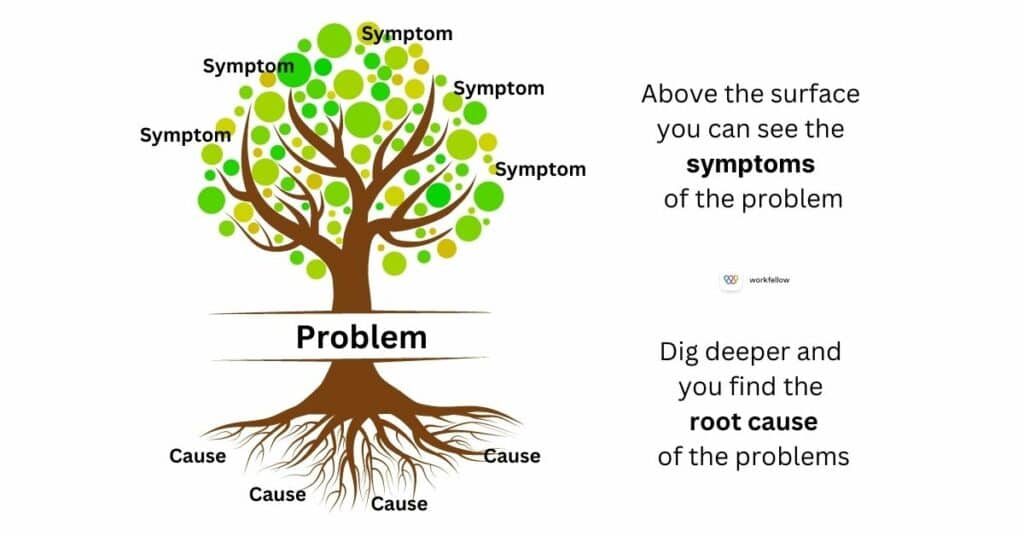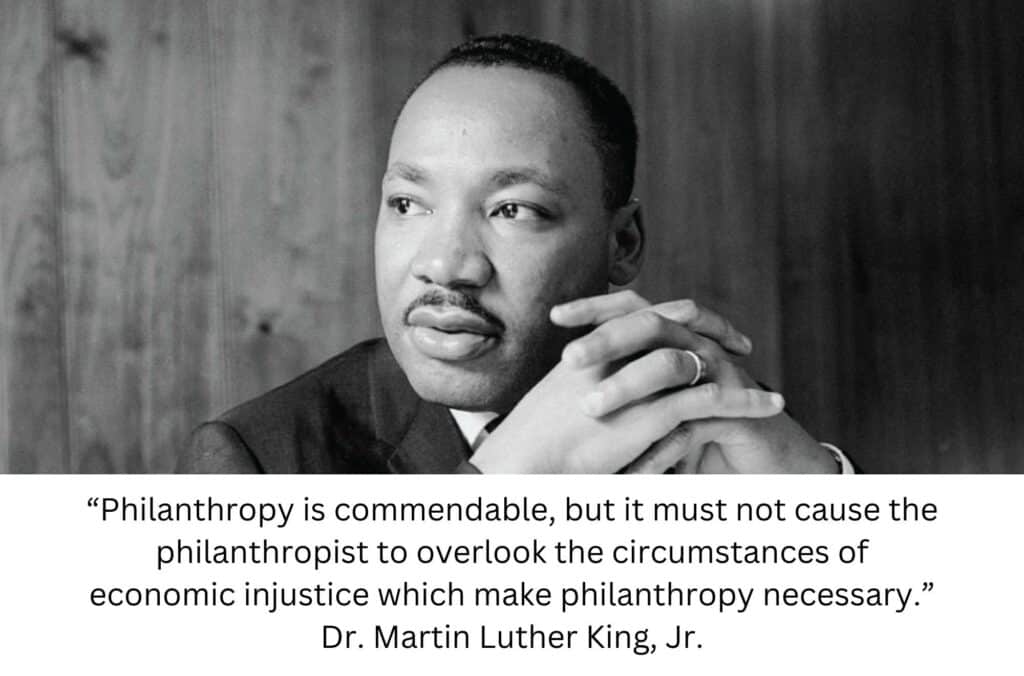For those of us giving to valiant causes, in the words of Martin Luther King, Jr., that is commendable. For those of us in the social impact sector working daily to improve life and solve important social problems, that is commendable. However, how do we ensure that we know that we are solving the right problem? If we don’t understand the root cause, we can’t develop the right solutions. Root cause analysis can help to differentiate between causes and symptoms of problems, so that we can be more strategic in addressing both the symptoms and the more complex causes.
What is Root Cause Analysis?
As social change leaders, we should always be asking the question what change needs to happen right now?
Pictured below is a root cause map of health issues from the Center for Disease Control and Prevention. While the “symptoms” such as depression and obesity still exist on the tree to the right, the idea here is that they decrease over time with fewer disparities seen by neighborhood, income level or race.

Nearly all social problems have root causes that are complex and not easily solved, and we design solutions for the symptoms rather than the real problem. Take homelessness, for example. Our most historic services are soup kitchens and temporary shelters which don’t address root causes such as mental illness, addiction, and poverty. In healthcare, as pictured above, we treat the symptoms that a patient brings once they are in the hospital or at the doctor’s office but have long struggled to address the root causes of health issues, known as the social determinants of health.
What happens if we keep addressing symptoms?
I worked in child welfare and human service organizations for 20 years of my life. Organizations that were seeking to build trusting relationships with families and provide a range of supports that research has long shown to be “protective factors” against abuse and neglect often struggled with funding. These were organizations or programs of organizations considered to be on the “prevention” side of child welfare. Other organizations or programs were focused on keeping children safe after they entered the foster care system, providing residential care or matching children with foster families and overseeing their placement (intervention).
On the prevention side of programming, we were asking “how can we support families to keep their children at home instead of entering foster care?”. On the intervention side we were asking, “what services can we offer to make sure that children are safe and thriving while in our care?” Over decades and decades, the federal and state child welfare systems swung back and forth between a mental model of believing children were removed from home too often and were better off with their families and believing that more foster placements were needed. When the system swung toward fewer removals, nothing changed about the funding, family resources, policies, etc. except that certain types of cases did not result in removal. Inevitably, children were just delayed coming into the system, entering a year later or in some cases child fatalities increased.
The root cause questions that no one was consistently asking and seeking to solve were questions like: what is it about our current system that results in so many children being removed from home? Why is there little to no money to fund prevention services? Why are so many children in the system due to neglect, with much of this neglect associated with poverty? Is poverty child neglect? Why do families who come into contact with systems like food stamps and other welfare programs have their children reported for potential abuse and neglect more often than families with higher incomes who don’t need to interact with these systems but have similar family dynamics? Why are black families reported for possible abuse or neglect more than white families?
In more recent years the system is finally beginning slow transformation with more funding for prevention. This change is slow, however, and the system is still rarely grappling with how prevention funding can address the root causes of poverty, or how bias impacts reporting and removal, etc. Root cause analysis is one tool in systems thinking, with a core principle being that all things are interconnected. This requires moving from linear thinking to more circular thinking, beginning to see how multiple systems and problems influence a problem for worse or for better.
How to do Root Cause Analysis:
While the solutions to complex problems are….well, complex, we can only begin to solve them if we treat the causes in addition to the symptoms. For change makers and philanthropists, Root Cause Analysis is a tool that can help. It is most effective if done across multiple sectors with varying perspectives because of the interconnection already discussed. It is also important to ensure that those currently experiencing the problem being solved are part of both helping to identify root causes, as well as designing solutions.

*Image above from https://teleanalysis.com/the-relevance-of-root-cause-analysis-in-problem-solving/
The steps in the process are simple, though finding the right solutions and working on them intensively over time to change systems is certainly not.
- Identify the problem: The problem should be stated in the form of a question. As described above in the child welfare example, we don’t always ask the right questions. Make sure your problem statement is general enough to dig into the root cause, and open ended to allow the 5 Whys exercise that follows.
Using a drawing similar to the one above, write your question on the trunk where you see “Problem”. Your question might be, for example, why are fewer teen moms in our community seeking early prenatal care? Or it might start higher level with a question like why are more teen moms in our community giving birth to low birth weight infants?
Ensuring that individuals in the room understand the problem deeply is important, and from different perspectives. Looking at data to understand causation is also key and why this exercise is sometimes facilitated by a subject matter expert, consultant or researcher who can bring data to the table as part of the conversation.
2. Identify root causes and symptoms: Here, everyone is asked to state their perception of “why” this is happening, pulling from their lived experience, professional experience and the data. This step might start with asking a question to help understand causality such as: what is present that results in this continuing to repeat itself? What factors are different for individuals experiencing these symptoms?

The facilitator can challenge the group on whether their answer is a root cause or a symptom of the problem, and might use the 5 Whys exercise to get deeper to the root cause of the problem. More on root cause, how to use, and potential pitfalls may be found here. These can be grouped on the picture as a root or a leaf to show which are symptoms and which are root causes.
3. Identify current solutions: To the side of the diagram, brainstorm current services or solutions that support the symptoms of the problem. Next, brainstorm those that help to address the root causes. This is where we are typically surprised by how much of our efforts are addressing symptoms.
This exercise helps us identify where there are gaps in solving the root cause. Treating the symptoms matters too, as long as the treatment does not exacerbate the root cause and as long as investment is being made in changing the systems that causing the issues. We can quickly shift and decide not to invest in the solutions that are not having a positive impact. Beginning to solve the root cause, however, is a much longer process that requires collective work by an entire community with a team of system thinkers. Coalitions and collective impact organizations are doing much of this work.
Think about the issues most important to you. Are you clear on the root cause? Who else needs to be at the table to help you identify it, ensuring that in the words of Dr. King, “you not overlook the circumstances of economic injustice which make philanthropy necessary.”

